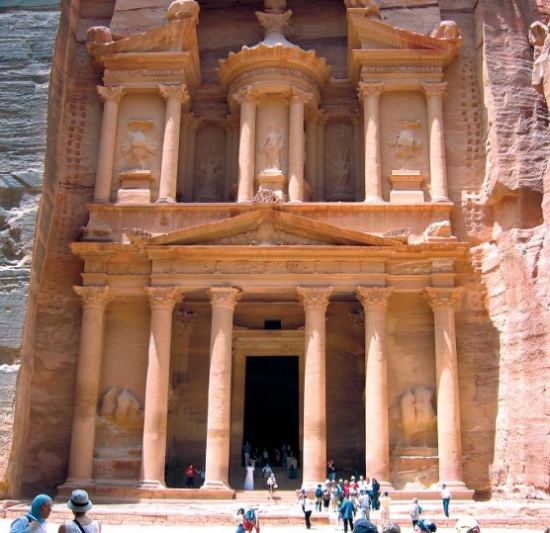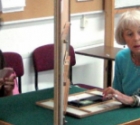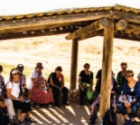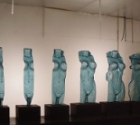
The Treasury
I am ashamed to admit that although I have flown thousands of kilometers and spent hours waiting for connections at some not too pleasant airports, I had not made the simple journey to what is definitely one of the greatest sights of the Middles East, if not of the world.
The decision to visit Jordan is, for Israelis, colored by factors other than the tourist sights, and for all the years since the peace agreement was signed between the two countries I had felt ambivalent about visiting. My “excuse” was that all the tours spent only one day in Petra and I had heard and read that this was not enough time to appreciate the ancient Nabatean capital city. On the other hand I remember how, in my youth movement days, we had sat enthralled as we listened to the stories about the attempts of young Sabras who felt the need to visit the red rock in order to prove their manliness.
My sister was coming on a visit to Israel, and my desire to do something special with her prompted me to suggest that we take a trip to Jordan for a few days. After reading about what there was to see, the number of days we had at our disposal and my uncertainty about the safety of moving about alone, we decided to restrict ourselves to Petra alone. In retrospect I think that we should have been more adventurous, and I would suggest including Wadi Rum which is situated between Akaba and Petra and so can easily be visited after crossing the border from Eilat. One can go either for a few hours or spend the night in a Bedouin tent and continue the next morning. Traveling time by taxi from the border crossing to Petra is less than two hours and my suggestion, so as not to be at the mercy of the taxi drivers waiting across the border, is to arrange in advance for a taxi to wait for you after the crossing. Although not critical it will save you some money and can be easily arranged by phone or email.
One’s base for seeing Petra is the small town of Wadi Musa situated next to Petra. Hotels vary from the simple to the luxurious and my advice is to stay in one close to the visitors’ center and thus avoid the need to take a taxi up and down the steep hill which leads to the town center. Food in most of the restaurants is simple, but for those who are looking for something more elegant, the Movenpick hotel near the entrance gate offers elegant surroundings, charges accordingly but unfortunately serves up mediocre food.
The Nabateans were originally a nomadic tribe of desert bandits who began arriving in the area in about the 6th century BCE. Slowly they renounced their nomadic life style and built cities along the trade routes. As they established these urban centers they altered their approach and provided trade caravans with the necessary services, a secure passage through their lands and a place to do business. All this in return for handsome taxes paid. Thus, with the well-guarded Petra as a base of power, the Nabateans were able to control the important roads to the coast south of the Dead Sea. They reached their peak during the 1st century BCE to the 1st century CE.
The decline of Petra came with the increase in sea transportation and in 106 CE, by agreement between Rome and the Nabatean king, the entire Nabatean kingdom was annexed by Rome, a period evidenced in the Roman theater.
The Nabateans left Petra sometime during the 4th century CE. The city was “lost” to the west for hundreds of years until in 1812, a Swiss traveler who had converted to Islam, ‘discovered’ the ruins. The local Bedouin, of course, had always been familiar with the site. (Strangely enough, there are Crusader ruins on top of one of the surrounding mountains.)
In Israel we are familiar with the Nabatean cities of Avdat, Shifta, Mamshit and Nitzana, all the way-stations along the trade route west, which catered to the traders and their camels. Laden with incense, spices and other luxuries of Roman life, the travelers had a place to eat and rest for the night.
At its peak there were about 30,000 people living in Petra and what we see today is only a shadow of its previous magnificence. One can easily imagine what it must have been like to arrive in Petra after a grueling trip through the desert, to see this enormous red rock city with fountains, gardens and gigantic, intricately carved tombs and temples.
Two thousand years of harsh weather, earthquakes and Bedouin marksmen have all had their effect on this unique city, but what we see today is still a wonder of the world. A wonder not to be missed especially when it’s in our neighbor’s yard.
After paying the rather hefty entrance fee (which varies depending on the length of one’s visit), there is a walk of about 1 km before one reaches the Siq, the dramatic, narrow, deep, 1.2 km long wadi, that leads one into the ancient city. Suddenly the sunlit façade of the most famous of Petra’s monuments appears; the Treasury, thus named due to a Bedouin belief that there is a treasure hidden in the solid stone urn at the top of the façade left there by Pharaoh while chasing the Israelites. The color may be red or pink depending on the time of day, but either way it will cause you to stare in wonder at its perfect proportions, at the beautiful detail that can still be seen and at its size – none of it built – all carved out of the sandstone rock. Sit and rest, and allow yourself time to absorb what it must have entailed to carve, by hand, this beautiful structure out of the side of the mountain. As with many of Petra’s buildings, the function of the Treasury is not clear. A tomb, temple, a place of sacrifice...?
Walking along the main way will allow one to see the tombs of the kings, the Roman theater that could hold 8,000 people, an enormous palace, Byzantine churches with intact mosaic floors and hundreds of caves and tombs. No less impressive, however, is the colored rock, perhaps best described by quoting the manservant and cook of the artist Edward Lear, who visited Petra in 1858. “Oh master” he said, “we have come into a world of chocolate, ham, curry powder and salmon!” I am sure that any further description of their vividness and beauty would only cause you to think that I am exaggerating. You will be pleasantly surprised to discover that I am not.
The amount one can see is only limited by the amount of time one can spend there. Trails lead off the main path, taking one to the top of the mountains, some of which have breathtaking views. These paths require either a decent level of fitness or the rental of a donkey from a Bedouin boy. Here one finds more carved buildings, the most impressive being the monastery, an hour’s climb up well-worn steps. As one ascends the air gets cooler and the wind picks up. On reaching the top, sit in the enterprising Bedouin café opposite this enormous building and dream of going back in time to visit what must have been a place of untold luxury built in the harshest of environments, where people from all over the “civilized world” wandered the streets. When you have cooled down and got your breath back, carry on to the viewpoint from where, if the visibility is good, you can see the Arava and beyond.
An interesting side trip is the route of the High Palace of Sacrifice, equally demanding and almost unvisited. From here come back via the tomb of the Roman soldier and Wadi Farasa in order to see what I think are the most impressive of the colored rock-lined caves.
Most people visit Petra for a few hours. We spent two full days there and didn’t manage to see all that we had hoped to see. Tailor your trip to your physical ability and the time available to you, but don’t miss this wonder of the world.
 THE RABBI’S DAUGHTER - A Review
THE RABBI’S DAUGHTER - A Review  Spotlight on .....Roz Brodie
Spotlight on .....Roz Brodie  ESRA COMPUTER CLUB
ESRA COMPUTER CLUB From Bible to Bedouins and Battles
From Bible to Bedouins and Battles Trip to the Dead Sea
Trip to the Dead Sea Japan
Japan Brian Braude
Brian Braude